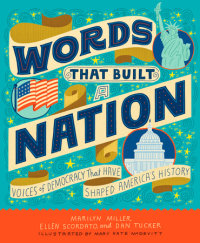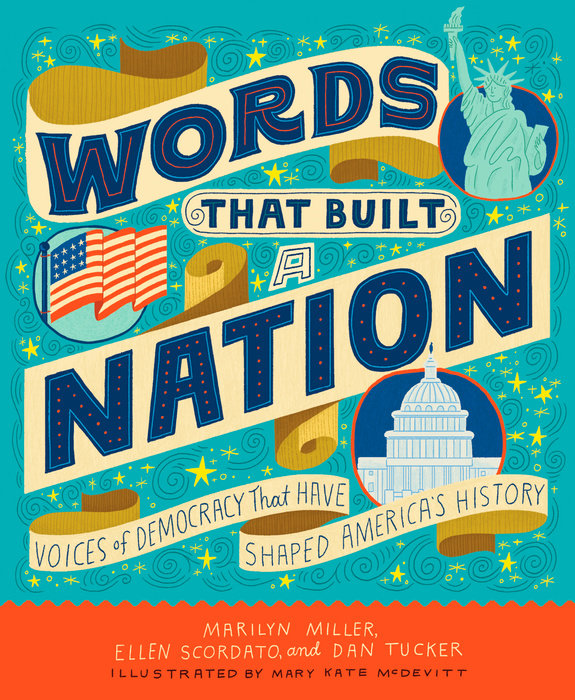Words That Built a Nation
The ultimate tour of United States' most inspiring speeches, quotes, and leaders—the perfect gift for kids who love history and want to make a difference in the future.
Together in one essential collection, this selection of the United States' most important historical documents and speeches immerses kids in the ideas and words that have shaped American democracy. Now, this young history lovers must-have gift has been revised and revamped for the 21st century. From the Gettysburg Address to the 2015 Supreme Court ruling on same-sex marriage, this updated edition introduces the landmark statements and moments that are impacting our nation today.
With powerful illustrations important background information and context, Words That Built a Nation is an up-to-date and breathtaking look at U.S. history.
An Excerpt fromWords That Built a Nation
Every day, Americans look to a document that’s well over two centuries old, written by men wearing breeches and using a quill pen, for guidance in making and enforcing the laws that govern our lives—down to the rules about the information our Internet providers are allowed collect about our Google searches. America’s founders never could have foreseen the Internet, but somehow, the words and principles they lay down in the United States Constitution in 1787 remain as relevant today as they were when they were written.
The Constitution remains the basis for our government, but is only one of many documents that have shaped and defined the American character. This book looks at the words and ideas from forty-one of the most important documents and speeches in American history. These are words that capture the battles, the crises, the values, and the politics of a developing government. These words are living history, telling the story of a new nation whose destiny was far from certain—and which continues, in the twenty-first century, to unfold. The words in this book, compiled from speeches, pamphlets, letters, declarations, and even songs, represent the past, present, and future of our nation.
When the Mayflower left the shores of England in 1620, its passengers were seeking religious freedom and escape from the seemingly endless wars that were plaguing Europe at the time. They regarded the New World as virgin territory—although Native Americans had been living there for millenia. Some of the Europeans simply wanted better economic opportunity. The leaders on the Mayflower knew that with the king and English authority so distant, they would need a governing document if they were to succeed as a colony in the New World. Before they even touched land, they developed the compact that bound them together in obedience first to God and to the king—but most importantly for the American story, to each other. The authority of their government came from the consent of the governed, and the idea of self-government was planted on North American soil. So began the series of trials and errors that turned settlements into colonies, colonies into states, and states into a nation.
The Mayflower Compact and other documents connect our past to our present. Generations of Americans since then have developed, interpreted, and applied the concepts in these documents to changing events and social conditions. From the Declaration of Independence (1776), to the Declaration of Sentiments (1848), to the Declaration of Indian Purpose (1961), this country’s sense of government, freedom, and citizenship runs through its veins and finds its expression in print.
Besides these cornerstone documents, many of the other documents chosen represent turning points in American history. Their existence altered the course, or direction, of the nation by influencing popular opinion, or by giving expression to the evolving values of the American population. Afterward, the country and the people were forever changed. This was true of Frederick Douglass’s account of his life as a slave, which informed a still-skeptical society of the horrors of slavery. Douglass’s 1852 speech about the meaning of the Fourth of July to black Americans—most of whom were still enslaved—still reverberates today.
Some of the documents included here expanded the idea of citizenship by letting more voices be heard in our society. This was not done without struggle. In 1870, the Fifteenth Amendment secured the vote for African-American men. Fifty years later, in 1920, the approval of the Nineteenth Amendment gave women the same right. In 2015, the Supreme Court extended the guarantees of equal treatment under the law to same-sex couples in the landmark Oberǵefell v. Hodǵes decision.
The nation’s expansion took economic forms as well. Although it began as a nation of farmers, the United States ultimately became a great industrial power. By the end of the nineteenth century, waves of immigrants searching for jobs entered the United States in greater numbers than before. Most of the newcomers settled in cities, where they added to the richness and diversity of American life. Included in this collection is a 1910 account by reformer Jane Addams of the poor conditions immigrants had to face. Indeed, as reformers like Addams tried to include newcomers in American life, prejudice against immigrants and minorities was widespread, and many Americans were concerned that immigrants would take their jobs away. In 1967, César Chávez’s moving words to striking Mexican farmworkers in California gave notice that the question of immigrants’ rights was far from resolved. Chavez’s speech led to dramatically improved working and living conditions for thousands of immigrant workers.
The Civil Rights movement was perhaps the defining movement of U.S. history in the latter part of the twentieth century. In 1954, the Supreme Court ruled in Brown v. the Board of Education that segregated schools favored whites at the expense of blacks, because black schools simply didn’t get the resources that white schools did. The ruling overturned the idea of “separate but equal,” which had been the law of the land, and which had allowed segregation to keep blacks from receiving opportunities for education and economic success equal to whites. Martin Luther King, Jr.’s 1963 “I Have a Dream’ speech built upon this assertion and led inexorably to the passage of the Civil Rights Act in 1964—a crucial milestone in the ongoing struggle for blacks to gain equal treatment under the law. Barack Obama’s speech on race, given when he was an Illinois senator campaigning for the presidency in 2008, provides a more recent picture of where that struggle stands

